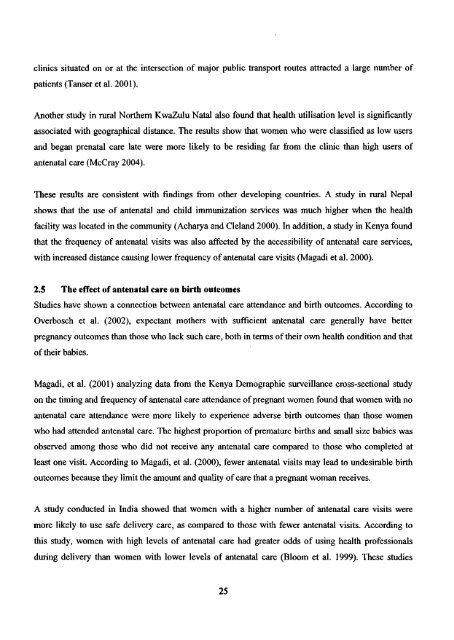an examination of the role of antenatal care attendance in ...
an examination of the role of antenatal care attendance in ...
an examination of the role of antenatal care attendance in ...
Create successful ePaper yourself
Turn your PDF publications into a flip-book with our unique Google optimized e-Paper software.
cl<strong>in</strong>ics situated on or at <strong>the</strong> <strong>in</strong>tersection <strong>of</strong> major public tr<strong>an</strong>sport routes attracted a large number <strong>of</strong><br />
patients (T<strong>an</strong>ser et al. 2001).<br />
Ano<strong>the</strong>r study <strong>in</strong> rural Nor<strong>the</strong>rn KwaZulu Natal also found that health utilisation level is signific<strong>an</strong>tly<br />
associated with geographical dist<strong>an</strong>ce. The results show that women who were classified as low users<br />
<strong>an</strong>d beg<strong>an</strong> prenatal <strong>care</strong> late were more likely to be resid<strong>in</strong>g far from <strong>the</strong> cl<strong>in</strong>ic th<strong>an</strong> high users <strong>of</strong><br />
<strong>an</strong>tenatal <strong>care</strong> (McCray 2004).<br />
These results are consistent with f<strong>in</strong>d<strong>in</strong>gs from o<strong>the</strong>r develop<strong>in</strong>g countries. A study <strong>in</strong> rural Nepal<br />
shows that <strong>the</strong> use <strong>of</strong> <strong>an</strong>tenatal <strong>an</strong>d child immunization services was much higher when <strong>the</strong> health<br />
facility was located <strong>in</strong> <strong>the</strong> community (Acharya <strong>an</strong>d Clel<strong>an</strong>d 2000). In addition, a study <strong>in</strong> Kenya found<br />
that <strong>the</strong> frequency <strong>of</strong> <strong>an</strong>tenatal visits was also affected by <strong>the</strong> accessibility <strong>of</strong> <strong>an</strong>tenatal <strong>care</strong> services,<br />
with <strong>in</strong>creased dist<strong>an</strong>ce caus<strong>in</strong>g lower frequency <strong>of</strong> <strong>an</strong>tenatal <strong>care</strong> visits (Magadi et al. 2000).<br />
2.5 The effect <strong>of</strong> <strong>an</strong>tenatal <strong>care</strong> on birth outcomes<br />
Studies have shown a connection between <strong>an</strong>tenatal <strong>care</strong> attend<strong>an</strong>ce <strong>an</strong>d birth outcomes. Accord<strong>in</strong>g to<br />
Overbosch et al. (2002), expect<strong>an</strong>t mo<strong>the</strong>rs with sufficient <strong>an</strong>tenatal <strong>care</strong> generally have better<br />
pregn<strong>an</strong>cy outcomes th<strong>an</strong> those who lack such <strong>care</strong>, both <strong>in</strong> terms <strong>of</strong> <strong>the</strong>ir own health condition <strong>an</strong>d that<br />
<strong>of</strong> <strong>the</strong>ir babies.<br />
Magadi, et al. (2001) <strong>an</strong>alyz<strong>in</strong>g data from <strong>the</strong> Kenya Demographic surveill<strong>an</strong>ce cross-sectional study<br />
on <strong>the</strong> tim<strong>in</strong>g <strong>an</strong>d frequency <strong>of</strong> <strong>an</strong>tenatal <strong>care</strong> attend<strong>an</strong>ce <strong>of</strong> pregn<strong>an</strong>t women found that women with no<br />
<strong>an</strong>tenatal <strong>care</strong> attend<strong>an</strong>ce were more likely to experience adverse birth outcomes th<strong>an</strong> those women<br />
who had attended <strong>an</strong>tenatal <strong>care</strong>. The highest proportion <strong>of</strong> premature births <strong>an</strong>d small size babies was<br />
observed among those who did not receive <strong>an</strong>y <strong>an</strong>tenatal <strong>care</strong> compared to those who completed at<br />
least one visit. Accord<strong>in</strong>g to Magadi, et al. (2000), fewer <strong>an</strong>tenatal visits may lead to undesirable birth<br />
outcomes because <strong>the</strong>y limit <strong>the</strong> amount <strong>an</strong>d quality <strong>of</strong> <strong>care</strong> that a pregn<strong>an</strong>t wom<strong>an</strong> receives.<br />
A study conducted <strong>in</strong> India showed that women with a higher number <strong>of</strong> <strong>an</strong>tenatal <strong>care</strong> visits were<br />
more likely to use safe delivery <strong>care</strong>, as compared to those with fewer <strong>an</strong>tenatal visits. Accord<strong>in</strong>g to<br />
this study, women with high levels <strong>of</strong> <strong>an</strong>tenatal <strong>care</strong> had greater odds <strong>of</strong> us<strong>in</strong>g health pr<strong>of</strong>essionals<br />
dur<strong>in</strong>g delivery th<strong>an</strong> women with lower levels <strong>of</strong> <strong>an</strong>tenatal <strong>care</strong> (Bloom et al. 1999). These studies<br />
25

















